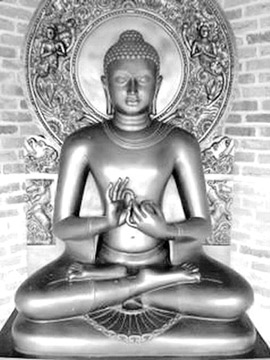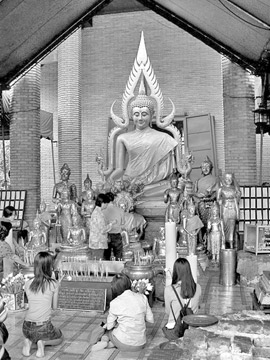Origins of image worship in Buddhism
by Kumudu GUNATHILAKA
 The Buddhist tradition reveals that there were images and drawn
portraits of the Thathagatha, displaying his contemporary likeness in
existence, during his lifetime. The sublime teaching of the Master
provides the complete Supra-Cosmic-psychology extant, that transcends
the three illusory planes of being. The Buddhist tradition reveals that there were images and drawn
portraits of the Thathagatha, displaying his contemporary likeness in
existence, during his lifetime. The sublime teaching of the Master
provides the complete Supra-Cosmic-psychology extant, that transcends
the three illusory planes of being.
It has no place for the worship of icons and idols. His followers
knew that form is not realistic. They offer flowers and burn incense and
light a lamp, not to expect favours, or offer prayers to the image of
the Master. Thereby they pay homage to the Master in gratitude.
The aim of the practitioner is to find which is beyond change. The
correct perspective of the Master, could be had through the idiom of the
‘Dhamma’. According to the reliable sources, it is evident that, the
authentic shape of the Thathagatha, has been preserved to-date.
It was the habit of the Master, to allow those assembled to receive
his blessings, before walk into the cell for a brief respite, after
pre-meridian repasts. When the master was away on a mission, those
followers who call for glimpse of the Master for His blessings, were
visibly saddened.
This situation came to the notice of King Pasenadi of Kosala, who
sought for the permission of the Master, to have his likeness cast, so
that people could still show their gratitude to the Master, without
feeling much about His absence.
First image
The request of the king was granted by the Master. Thus, in the very
lifetime of the Master, the first image of the Thathagatha was carved,
with his permission, in white sandalwood, at the behest of King Pasenadi
of Kosala.
The Master examined the finished image, and assented that it
resembled Him in mien. A complete account with more details of making
this sandalwood image of the Master is in ‘Kosala Bimba Warnana’.
The illustrious Fa-Hien tells that, King Pasenadi of Kosala, who had
known and revered the Thathagatha from his young manhood, until he and
the Master were eighty, caused an image of the Master, to be carved in
Sandalwood, and this was the first images of the Master, and became the
specimen for all subsequent ones.
Fa-Hien saw this image at Jethavanaramaya in the fifth century A.D.
Puri, the present seaside resort of Orissa, was the ancient capital
Odanthapuri of King Brahmadaththa, from where the Tooth Relic of the
Thathagatha, was taken to King Kithsirimevan of Sri Lanka, by Prince
Dhantha and Princess Hemamala, for its protection.
Today this ancient site is full of Buddhist associations. Most of the
noble monuments of the ancient Indian civilization were destroyed by the
iconoclastic invaders in the 11th and 12th centuries.
 Buddhists were able to shift the sandalwood image of the Master to
Puri for protection. Sir Edwin Arnold and Anagarika Dharmapala
identified this image, worshipped by Buddhists and Hindus alike in Puri,
as the original sandalwood image of the Thathagatha, carved by King
Pasenadi of Kosala, 2500 years ago. Buddhists were able to shift the sandalwood image of the Master to
Puri for protection. Sir Edwin Arnold and Anagarika Dharmapala
identified this image, worshipped by Buddhists and Hindus alike in Puri,
as the original sandalwood image of the Thathagatha, carved by King
Pasenadi of Kosala, 2500 years ago.
The temple of ‘Jagannatha’ of Puri in Orissa was considered as one of
the eight Holy Places of worship in India, on the basis of Thathagatha’s
Relics. Huen Tsiang described about five Chetiyas where the Relics of
the Master were preserved.
The Buddhists believed that, the Rib-Bone of the Thathagatha, still
remain in the wooden image of ‘Jagannatha’. Indian scholars agree that,
all the ancient cave temples of Puri in Orissa, have been the work of
the primitive Buddhists.
King Chandasoriya of Arakan, on hearing about the fame and the
sublime teaching of the Thathagatha, decided to visit central India, and
pay homage to the Master.
Knowing the good intension of the noble monarch, the Master, with his
brethren visited Selagiri of Arakan, and showed six places in the
vicinity to the disciples, where the Bodhisathya spent six of his
previous existences.
On hearing the presence of the Great Teacher to his kingdom, King
Chandasoriya arrived Selagiri with alms and offerings.
The Master instructed the King and his subjects in the five and eight
precepts, and about the ten great virtues, a righteous monarch should
observe. The king invited the Master and the disciples to his capital,
‘Dannawathi where the Master delivered sermons to the people for a week.
The pious King made a request to the Master seeking permission to
cast his likeness, for them to pay homage thereafter. The wish was
granted, and the Master rested under a hanyan tree on Siriguththa Hill.
The likeness of the Thathagatha cast by them was extraordinary. The
king ordered his men to place the statue on a jewelled throne, in a
shrine surmounted by a carved spire, built on the summit of the
Siriguththa hill.
“I shall pass into Nibbana in my 80th year, but you, instinct with my
essence will live five-thousand years, which is the life-span of my
teaching”.
The Master addressed the image thus, and took His departure, after
delivering the final sermon to Arakans there. This image remained on the
summit of the hill for 2400 years, before reaching Mandale.
Arakan was invaded by Mongolians who destroyed the capital in 957 AD.
Arakans came back to power in 1060 AD and renovated the temple destroyed
by the invaders.
The kings had a great veneration for it, and attempted to take it to
Burma, on several occasions. Failing which, they often made pilgrimage
to the shrine. Arakan became the land of the great image.
Burma united under its Lung-Paya dynasty in 1784, invaded and
acquired Arakan. The Burmese monarch took the great image of Siriguththa
hill, to his Capital, Mandalay where it is installed at present.
The British acquired Burman in 1885. The original city built by King
Chandasoriya, walls of the Siriguththa hill temple including its three
courts, the reservoir, statues of the guarding angles, and many more
others have been discovered by the British archaeologists.
In the library of King Tri-Tu-Dhamma, situated in the first court of
the temple, near the west gate of the Siriguththa hill, there was a
number of ancient books on ola-leaf manuscripts.
Compassion
The most ancient and notable was known as ‘Sappadana Prakarana’,
which provides a detailed account of the Thathagatha’s visit to Arakan,
and casting of the image of the Master, and the erection of the temple
premises on Siriguththa hill by King Chandasoriya to mark the visit of
the Great teacher, to his country.
This famous image, a bronze, ten feet high, represent the Thathagatha,
legs folded left hand opened on the lap, the right touching the earth,
with the tip of the finger, a symbolical gesture denoting compassion for
all beings. This image was the blood, and life of the Arakans.
It is the object of fervent worship by millions of pilgrims monthly
throughout the ages. It has been coated so thickly with gold-leaf each
year, and its original slender and antique beauty, i.e. the true
likeness of the Thathagatha, has been hidden from the world at present.
The great poet Kshemendra sings in Sanskrit verse in his
‘Avadanakalpalatha’ which the Thathagatha, through itinerant merchants,
sent to princess Mukthalatha of Lanka, a drawn portrait of the Master,
and instructions on Dhamma written on a cloth, in response to her
inquiry about the sublime teaching.
She practised accordingly keeping the portrait as a meditational aid,
and attained the four stages of sainthood. She was the recorded Lankan
to realise Nibbana during the life of the Master.
Once on the advice of the Master, King Bimbisara sent a portrait of
the Thathagatha with a sermon scribed on a plate of gold, to the King of
Roruka, according to Divyawadana-Rudrayanavadana.
On another occasion, on the advice of the Master, King Bimbisara sent
a portrait of the Master drawn on a refine cloth, together with a
message in Magadhi, scribed on plates of gold, to the King of Gandhara.
On both occasions the kings and their people accepted the sublime
teaching.
These are few instances where the likeness of the Thathagatha was
cast and drawn, with the dawn of the Buddhist Era. |

